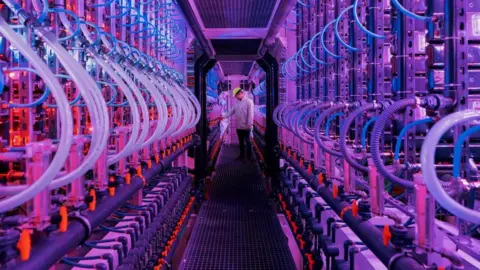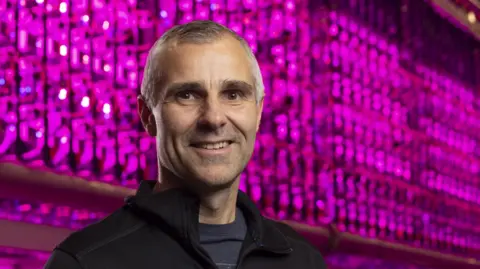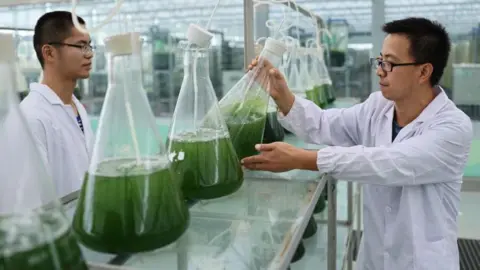
 It grows
It growsIn the shadow of Iceland's largest geothermal power plant is a large warehouse housing a high-tech indoor farm like I've never seen before.
Under an eerie pink-purple glow, illuminated panels buzz and cylindrical columns of water spread out, with a future crop of microalgae growing.
Vaxa Technologies in Iceland has developed a system that harnesses energy and other resources from a nearby power station to grow these tiny aquatic organisms.
“It's a new way of thinking about food production,” says general manager Kristin Havlidason, as he gives me a tour of the space-age facility.
For most of our history, humans have consumed seaweeds, also known as macroalgae.
But its smaller relative, microalgae, was a less common food source, although it was eaten for centuries in ancient Mesoamerica and Africa.
Now scientists and entrepreneurs are increasingly exploring its potential as a nutritious and sustainable food.
About 35 minutes from the capital, Reykjavik, the Vaksa site produces NannoChloropsis microalgae, both as food for people, and as feed for fish and shrimp farming.
They also grow a type of bacteria called Arthospira, also known as blue-green algae, because they share similar properties with microalgae.
When dried it is known as spirulina and is used as a nutritional supplement, food ingredient, and as a bright blue food coloring.
These microorganisms perform photosynthesis, capturing energy from light to absorb carbon dioxide and release oxygen.
“The algae eat carbon dioxide, or convert carbon dioxide into biomass,” Mr. Havlidason explains. “It's carbon negative.”
 It grows
It growsThe Vaxa plant is in a unique situation.
It is the only place where algae farming is combined with a geothermal power plant, which provides clean electricity, provides cold water for agriculture, hot water for heating, and even pipes via carbon dioxide emissions.
“You end up with a slightly negative carbon footprint,” says Asger Munk Smit Jensen, a food technology consultant at the Danish Institute of Technology (DTI), who co-authored a study assessing the environmental impact of Vaxa's spirulina production.
“We also found a relatively low footprint, both in terms of land and water use.”
Round-the-clock renewable energy, as well as a flow of carbon dioxide and nutrients with a low carbon footprint, are needed to ensure the setup is climate-friendly, and he believes this is not easy to replicate.
“There is a huge energy input to run these photobioreactors, and you have to artificially mimic the sun, so you need a high-energy light source,” he explains.
“The main conclusion I propose is that we should use these areas (such as Iceland) where we have low-impact energy sources to make energy-intensive products,” adds Mr Munk Smit Jensen.
 It grows
It growsBack at the algae factory, I climbed to a raised platform, where I was surrounded by bustling modules called photobioreactors, where thousands upon thousands of tiny red and blue LEDs fuel the growth of microalgae, rather than sunlight.
They are also provided with water and nutrients.
“More than 90% of photosynthesis takes place within very specific wavelengths of red and blue light,” Mr. Havlidason explains. “We just give them the light they use.”
He adds that all conditions are tightly controlled and optimized through machine learning.
About 7% of the crop is harvested daily, and is quickly replenished by new growth.
Vaxa's facility can produce up to 150 metric tons of algae annually, and it plans to expand.
Since the crops are rich in protein, carbohydrates, omega-3 fatty acids and vitamin B12, Mr Havlidason believes growing microalgae in this way could help tackle global food insecurity.
Many other companies are betting on the potential of microalgae, with estimates suggesting the market will be worth $25.4bn (£20.5bn) by 2033.
Danish startup Algiecel has trialled portable, shipping container-sized units containing photobioreactors, which can be linked to carbon-emitting industries to capture carbon dioxide, while simultaneously producing food and feed.
The crops are also used in cosmetics, medicines, biofuels and to replace plastics.
Perhaps microalgae could also be produced in space.
In a project funded by the European Space Agency, the Danish technology foundation plans to test whether microalgae can be used Grown on the International Space Station.
 Getty Images
Getty ImagesDespite all the investments, there is still a long way to go before microalgae becomes an everyday part of our diet.
It still needs a lot of development, according to Mr. Munk Smit Jensen.
He notes that the texture lacks firmness. Meanwhile, the taste can be “fishy” if the algae is a saltwater species.
“But there are ways around this,” he adds.
There is also the societal question.
“Are people ready for this? How do we make it so everyone wants to eat this?”
Malin Lehme Olsen, a food scientist at the University of Copenhagen who researches microalgae, says their nutritional value needs more research.
“The green microalgae (chlorella) has a very strong cell wall, so it can be difficult for us to digest it and get all the nutrients,” she says.
For now, she says, it's better to add microalgae to other “carrier products” like pasta or bread to help with taste, texture and appearance.
However, Ms Olsen believes microalgae is a promising future food.
“If you compare one hectare of soybeans in Brazil, and imagine we have one hectare of algae field, you can produce 15 times more protein per year (from algae).”

Back at the factory, I was looking at unappetizing green sludge. It is the harvested microalgae with water, ready for further processing.
Mr. Havlidason offered me a taste, and after initial hesitation, I tried some and found it had a neutral flavor with a tofu-like texture.
“We are absolutely not suggesting that anyone eat green sludge,” Havlidason jokes.
Instead, processed algae is an ingredient in everyday foods, and in Reykjavik, a bakery makes bread with spirulina, and a gym puts it in smoothies.
“We're not going to change what you eat. We're just going to change the nutritional value of the foods you eat.”










